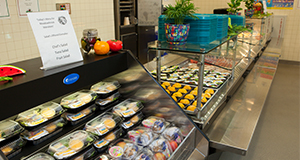Abstract
This publication reviews types of food environment disparities and their implications for food and nutrition security. Written by Alicia Papanek, Catherine G. Campbell, and Karla Shelnutt, and published by the UF/IFAS Department of Family, Youth and Community Sciences, May 2023.
References
Breyer, B., & Voss-Andreae, A. (2013). Food Mirages: Geographic and Economic Barriers to Healthful Food Access in Portland, Oregon. Health & Place, 24, 131–139. https://doi.org/10.1016/j.healthplace.2013.07.008
Calloway, E. E., Carpenter, L. R., Gargano, T., Sharp, J. L., & Yaroch, A. L. (2022). Development of New Measures to Assess Household Nutrition Security, and Choice in Dietary Characteristics. Appetite, 179, 106288. https://doi.org/10.1016/j.appet.2022.106288
Caspi, C. E., Sorensen, G., Subramanian, S. V., & Kawachi, I. (2012). The Local Food Environment and Diet: A Systematic Review. Health & Place, 18(5), 1172–1187. https://doi.org/10.1016/j.healthplace.2012.05.006
CDC. (2021). About Nutrition. https://www.cdc.gov/nutrition/about-nutrition/index.html
Cooksey-Stowers, K., Schwartz, M. B., & Brownell, K. D. (2017). Food swamps predict obesity rates better than food deserts in the United States. International Journal of Environmental Research and Public Health, 14(11), 1366. https://doi.org/10.3390/ijerph14111366
CRS. (2021). Defining Low-Income, Low-Access Food Areas (Food Deserts). https://crsreports.congress.gov/product/pdf/IF/IF11841
Cummins, S., Flint, E., & Matthews, S. A. (2014). New neighborhood grocery store increased awareness of food access but did not alter dietary habits or obesity. Health Affairs, 33(2), 283–291.
Dubowitz, T., Ghosh-Dastidar, M., Cohen, D. A., Beckman, R., Steiner, E. D., Hunter, G. P., Florez, K. R., Huang, C., Vaughan, C. A., Sloan, J. C., Zenk, S. N., Cummins, S., & Collins, R. L. (2015). Diet and perceptions change with supermarket introduction in a food desert, but not because of supermarket use. Health Affairs, 34(11), 1858–1868. https://doi.org/10.1377/hlthaff.2015.0667
Engler-Stringer, R., Fuller, D., Abeykoon, A. M. H., Olauson, C., & Muhajarine, N. (2019). An Examination of Failed Grocery Store Interventions in Former Food Deserts. Health Education & Behavior, 46(5), 749–754. https://doi.org/10.1177/1090198119853009
Fleischhacker, S. E., Evenson, K. R., Rodriguez, D. A., & Ammerman, A. S. (2011). A Systematic Review of Fast Food Access Studies. Obesity Reviews, 12(5), e460–471. https://doi.org/10.1111/j.1467-789X.2010.00715.x
Hager, E. R., Cockerham, A., O'Reilly, N., Harrington, D., Harding, J., Hurley, K. M., & Black, M. M. (2017). Food Swamps and Food Deserts in Baltimore City, MD, USA: Associations with Dietary Behaviours among Urban Adolescent Girls. Public Health Nutrition, 20(14), 2598–2607. https://doi.org/10.1017/s1368980016002123
HHS. (2022). White House Conference on Hunger, Nutrition, and Health. Retrieved November 21, 2022. https://health.gov/our-work/nutrition-physical-activity/white-house-conference-hunger-nutrition-and-health
Holben, D. H., & Marshall, M. B. (2017). Position of the Academy of Nutrition and Dietetics: Food Insecurity in the United States. Journal of the Academy of Nutrition and Dietetics, 117(12), 1991–2002. https://doi.org/10.1016/j.jand.2017.09.027
Joyner, L., Yague, B., Cachelin, A., & Rose, J. (2022). Farms and Gardens Everywhere but Not a Bite to Eat? A Critical Geographic Approach to Food Apartheid in Salt Lake City. Journal of Agriculture Food Systems and Community Development, 11(2). https://doi.org/10.5304/jafscd.2022.112.013
Karpyn, A. E., Riser, D., Tracy, T., Wang, R., & Shen, Y. E. (2019). The Changing Landscape of Food Deserts. United Nations System Standing Committee on Nutrition, 44, 46–53. https://pubmed.ncbi.nlm.nih.gov/32550654
Li, J. J., & Kim, C. (2022). Household Food Shopping Locations beyond Residential Neighborhoods: An Exploratory Study Using a GPS-Based Household Survey. Professional Geographer. https://doi.org/10.1080/00330124.2022.2075402
Li, Y. M., Luo, M. Y., Wu, X. Y., Xiao, Q., Luo, J. Y., & Jia, P. (2021). Grocery Store Access and Childhood Obesity: A Systematic Review and Meta-Analysis. Obesity Reviews, 22. https://doi.org/10.1111/obr.12945
Moran, A. J., Gu, Y., Clynes, S., Goheer, A., Roberto, C. A., & Palmer, A. (2020). Associations between Governmental Policies to Improve the Nutritional Quality of Supermarket Purchases and Individual, Retailer, and Community Health Outcomes: An Integrative Review. International Journal of Environmental Research and Public Health, 17(20). https://doi.org/10.3390/ijerph17207493
Morland, K. B. (2015). Local Food Environments: Food Access in America. Taylor & Francis Group, LLC.
Morland, K. B., & Evenson, K. R. (2009). Obesity Prevalence and the Local Food Environment. Health & Place, 15(2), 491–495. https://doi.org/10.1016/j.healthplace.2008.09.004
O'Hara, S., & Toussaint, E. C. (2021). Food Access in Crisis: Food Security and COVID-19. Ecological Economics, 180, Article 106859. https://doi.org/10.1016/j.ecolecon.2020.106859
Phillips, A. Z., & Rodriguez, H. P. (2019). Adults with diabetes residing in "food swamps" have higher hospitalization rates. Health Services Research, 54, 217–225. https://doi.org/10.1111/1475-6773.13102
Rhone, A., Ver Ploeg, M., Williams, R., & Breneman, V. (2019). Understanding Low-Income and Low Access Census Tracts across the Nation: Subnational and Subpopulation Estimates of Access to Healthy Food. https://ageconsearch.umn.edu/record/289136/?ln=en
Sadler, R. C., Gilliland, J. A., & Arku, G. (2016). Theoretical Issues in the 'Food Desert' Debate and Ways Forward. GeoJournal, 81(3), 443–455. https://doi.org/10.1007/s10708-015-9634-6
Savelle, R., & O’Neal, L. J. (2017). Food Insecurity and Obesity. EDIS, 2017(2), FCS3342/FY1473. https://doi.org/10.32473/edis-fy1473-2017
Schlangen, K. (2021). Food Apartheid. https://conservancy.umn.edu/bitstream/handle/11299/220359/4.6.2021_Food%20Apartheid.pdf?sequence=1
Simelane, K. S., & Worth, S. (2020). Food and Nutrition Security Theory. Food and Nutrition Bulletin, 41(3), 367–379. https://doi.org/10.1177/0379572120925341
Sullivan, D. M. (2014). From Food Desert to Food Mirage: Race, Social Class, and Food Shopping in a Gentrifying Neighborhood. Advances in Applied Sociology, 4(01), 30.
United States Census Bureau. (2022). Census Tract. https://www.census.gov/programs-surveys/geography/about/glossary.html#par_textimage_13
USDA. (2021). Documentation. https://www.ers.usda.gov/data-products/food-access-research-atlas/documentation/#comparisons
USDA. (2022). Key Statistics & Graphics. https://www.ers.usda.gov/topics/food-nutrition-assistance/food-security-in-the-u-s/key-statistics-graphics/#foodsecure
USDA, & HHS. (2020). Dietary Guidelines for Americans, 2020–2025. https://www.dietaryguidelines.gov/sites/default/files/2021-03/Dietary_Guidelines_for_Americans-2020-2025.pdf
Ver Ploeg, M., Breneman, V., Dutko, P., Williams, R., Snyder, S., Dickens, C., & Kaufman, P. (2012). Access to Affordable and Nutritious Food: Updated Estimates of Distance to Supermarkets Using 2010 Data. https://www.ers.usda.gov/webdocs/publications/45032/33845_err143.pdf?v=41505
Walker, R. E., Keane, C. R., & Burke, J. G. (2010). Disparities and Access to Healthy Food in the United States: A Review of Food Deserts Literature. Health & Place, 16(5), 876–884. https://doi.org/10.1016/j.healthplace.2010.04.013
Woodruff, R. C., Raskind, I. G., Harris, D. M., Gazmararian, J. A., Kramer, M., Haardorfer, R., & Kegler, M. C. (2018). The Dietary Impact of Introducing New Retailers of Fruits and Vegetables into a Community: Results from a Systematic Review. Public Health Nutrition, 21(5), 981–991. https://doi.org/10.1017/s1368980017003226
Wright, A. (2021). Interactive web tool maps food deserts, provides key data. Retrieved June 27, 2022. https://www.usda.gov/media/blog/2011/05/03/interactive-web-tool-maps-food-deserts-provides-key-data#:~:text=In%20the%20Food%20Desert%20Locator,supermarket%20or%20large%20grocery%20store
Yamaguchi, M., Praditsorn, P., Purnamasari, S. D., Sranacharoenpong, K., Arai, Y., Sundermeir, S. M., Gittelsohn, J., Hadi, H., & Nishi, N. (2022). Measures of Perceived Neighborhood Food Environments and Dietary Habits: A Systematic Review of Methods and Associations. Nutrients, 14(9), Article 1788. https://doi.org/10.3390/nu14091788

